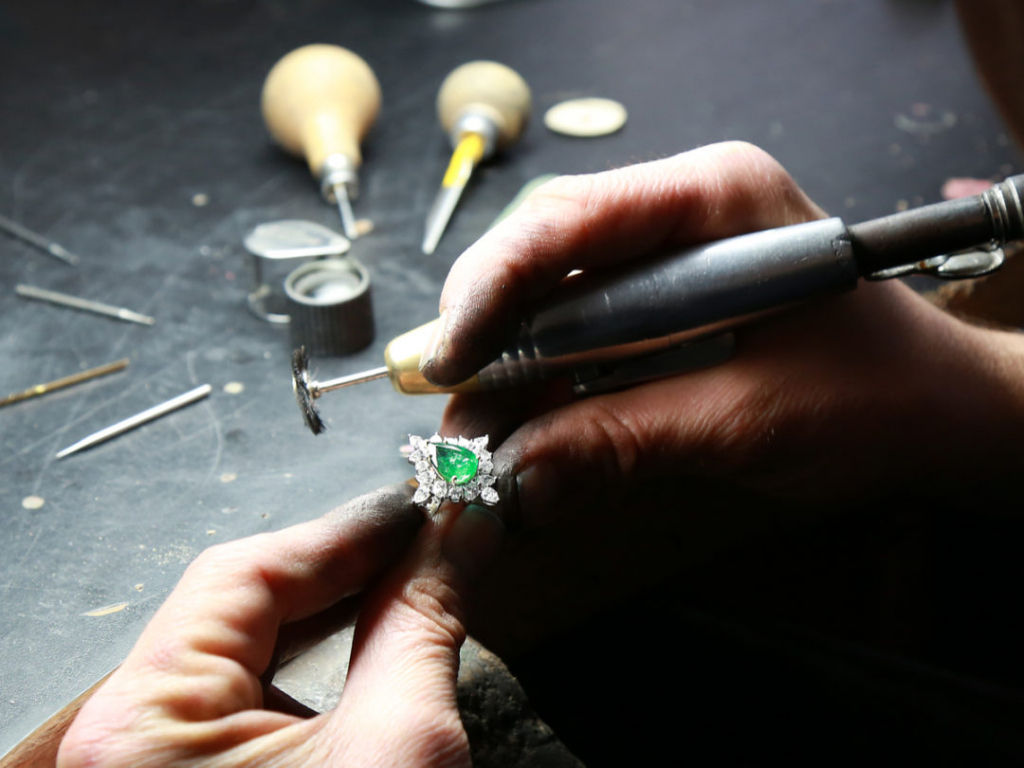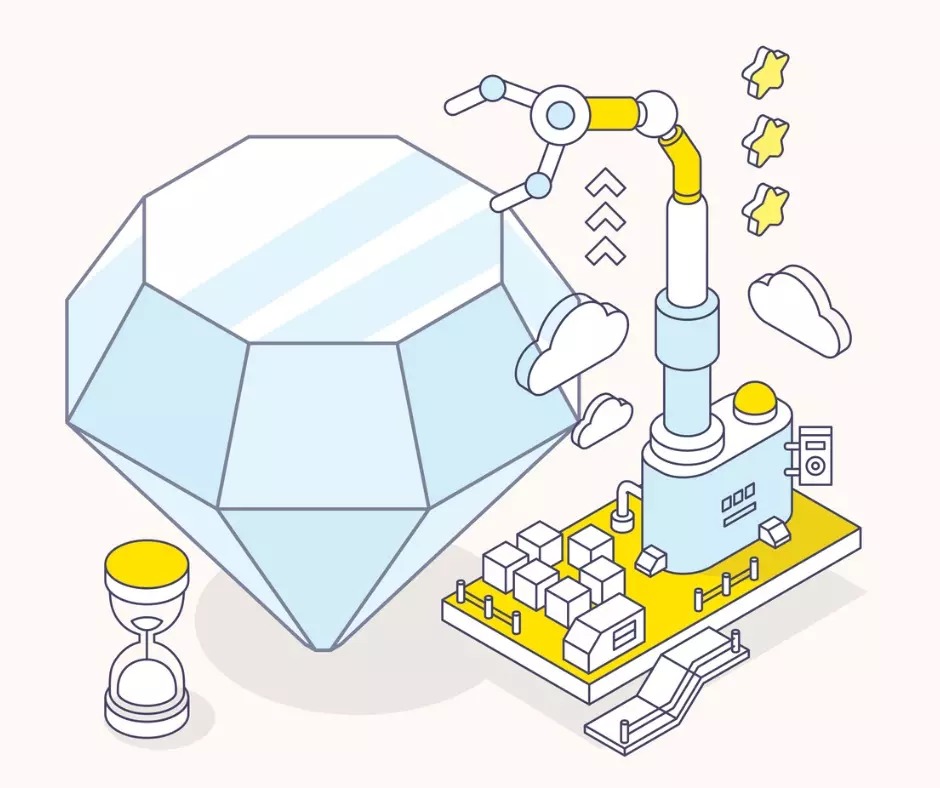From shells made into beads 150,000 years ago to laser-cut diamonds and digital ring sizers, it’s safe to say that technology plays a huge role in the advancement of the jewelry industry.
The Jewelry Industry
For thousands of years, technology and the jewelry industry have gone hand-in-hand, changing the way that jewelers create, advertise, and sell their wares. Now, the rapid increase in technological evolution is creating opportunities beyond the wildest dreams of the craftspeople of centuries, or even decades, ago.

Modern tech is impacting the fashion world and the jewelry industry in a number of exciting ways. New advancements and inventions are emerging all the time, and jewelers are embracing them. Here are 9 ways tech is changing the world of jewelry.
The Revolution Of 3D Printing on The The Jewelry Industry
While the jewelry industry has used 3D printing for several years now, this modern technology has only recently become more affordable and widely available. Greater access to this tech has given jewelers opportunities to create custom pieces with greater ease.
3D printing has also made it easier for jewelers to create more detailed and intricate designs than traditional design and manufacturing methods allowed. Combining this technology with computer-aided design (CAD/CAM) has created even greater opportunities, as you’ll see below.
Enhanced CAD/CAM Technology
CAD technology is revolutionizing the way jewelers design jewelry, especially when it comes to one-of-a-kind and custom pieces. In addition to being able to create rare items, CAD/CAM lets jewelers mass-produce designs that would take significantly longer to create by hand.

Additionally, CAD/CAM helps to reduce human error and to create jewelry with greater precision. After the CAD/CAM technology outputs a digital file with perfect proportions, the jeweler can use that design to create a 3D-printed model of the piece in thermoplastic wax. The customer’s preferred metal is then melted and poured into the 3D mold. When set, the jeweler will add the customer’s preferred gemstones according to exact specifications before giving the piece a final polish.
This process eliminates much of the traditional steps of jewelry manufacturing. The results are faster production times, lower labor costs, and the ability to offer customers more personalized service.
Advancing Laser Technology
Laser technology is also impacting the design and manufacture of jewelry. Using laser-powered tools, jewelers can create far more intricate designs than they could do by hand. Plus, lasers make it possible to shape and cut gemstones with greater precision, resulting in gems with fewer human-created flaws and with greater beauty and rarity.
The Rise Of Robotics
As with 3D printing and laser technology, robotics have been used in the jewelry industry for a while. And, like those other two modern technologies, it’s become more affordable and widespread. While robotics does have some design applications, the real impact of this modern technology on the jewelry industry is in the manufacturing process.

Thanks to robotics, it’s easier and more affordable for jewelers to create custom pieces for customers. Robotics also makes it possible for jewelers to create far more complex designs than were possible with traditional manufacturing methods.
Nano Technology Moves Forward
Nano technology allows users to manipulate matter at molecular and even atomic levels. The impact of this technology on the jewelry industry has the potential to be far-reaching, as jewelers can create devices and materials with unique properties.
A great example of this is how new types of gemstones and diamonds are being developed. Using nanotechnology, jewelers can create gems that have never been seen before in the natural world. This tech has enabled jewelers and gemologists to develop unique diamonds that are less flawed, more brilliant, and harder than the gems formed deep in the earth over thousands of years.
Innovative Electroforming
Even though electroforming is a relatively new process that still must be perfected, it’s already impacting the jewelry industry. Using this process, jewelers can use electricity to coat objects with various metals. The process also allows them to create new metal types that are harder and more durable than the metals traditionally used in jewelry manufacturing.
Beyond these revolutionary applications, electroforming makes it possible to create jewelry with more intricate designs and patterns, and to manufacture unique custom pieces for customers.
Wearable Technology Trends
Until recently, jewelry’s purpose was to accessorize outfits and enhance the beauty and/or indicate the status of the wearer. The introduction of wearable technology has allowed jewelers to create jewelry that serves a greater purpose while still enhancing the wearer’s outfit.
Wearers can connect smart rings and smart bracelets to handheld devices for various applications. For example, they can monitor their activity, such as the number of steps they take in a day, monitor their heart rate and sleeping patterns, and they can receive emails and instant messages.
Social Media Steps Up on The Jewelry Industry
In the past, jewelers were limited to newspapers, magazines, radio, and TV when advertising their wares. The advent of the internet in the mid-90s enabled them to expand their advertising and marketing channels dramatically. With the growth and development of social media over the last two decades, exciting new channels have opened up.
A growing number of jewelers are using social media platforms like Facebook, Instagram, and TikTok to reach a much wider audience at a fraction of the cost of traditional advertising methods. Anyone can write a Facebook ad, create an Instagram-sponsored post, or promote a video on TikTok to advertise a sale or their offering online.
Advancement Of Online Shopping Platforms And AR
While larger jewelry companies have had the resources to develop e-commerce platforms, this has not always been possible for smaller independent jewelers. This has changed, thanks to the development of platforms such as Shopify, Etsy, and other online marketplaces. Using these platforms, jewelers can sell directly to customers around the world. In addition to allowing jewelers to reach a global market, these e-commerce platforms also provide greater control over a business.
This modern technology has enhanced the customer experience too. Customers can more easily compare prices to find the best jewelry deals. If jewelers have integrated augmented reality (AR) into their online shopping platforms, customers can use it to enjoy a similar experience to what they would have in an actual store.
One of the biggest drawbacks of a standard online shopping platform is that customers cannot try on the jewelry they like. AR changes that by allowing customers to virtually try on everything from rings to bracelets to body jewelry. This gives them confidence in their purchases as they have a real-world representation of what they’ll look like.
A Future Of Possibilities in The Jewelry Industry
The jewelry industry and its customers have always benefited from developments in technology. Thanks to modern technologies, this thousands-of-years-old industry is growing in greater leaps and bounds than ever before.
Like this article? Then you must read this one: Virtual Runway: is Digital the Future of Fashion Shows?
* Written by Megan Hudson
Editor’s Note: The opinions expressed here by Fashinnovation’s columnists are their own, not those of Fashinnovation.






